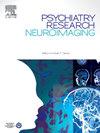Neural indices of cognitive reappraisal impact the association between childhood trauma and suicide risk in adulthood
IF 2.1
4区 医学
Q3 CLINICAL NEUROLOGY
引用次数: 0
Abstract
Background
Childhood trauma exposure is a risk factor for suicide. However, not all trauma exposed individuals experience suicidal urges and core factors moderate this risk pathway. Individual differences in volitional emotion regulation capacity may be one key factor that shapes the association between childhood trauma and suicide; however, few studies have comprehensively investigated these associations using both subjective and objective indicators of emotion regulation. We therefore utilized a multimodal design with 80 adults reporting active suicidal urges.
Methods
Participants completed self-report forms capturing suicidogenic cognitions and severity of suicidal ideation. Volitional cognitive reappraisal was measured using self-report and prefrontal cortex activation (PFC; i.e., ventrolateral and dorsolateral) during instructed reappraisal with functional magnetic resonance imaging.
Results
Hierarchal linear regression analyses revealed evidence of childhood trauma by PFC activation interactions on suicide risk. At low levels of vlPFC activation, but not high levels, greater childhood trauma was associated with greater suicidal ideation severity and suicide cognitions. Similarly, at low levels of dlPFC activation, but not high levels, greater childhood trauma was associated with suicide cognitions.
Conclusion
Hypoactivation of regulatory PFC regions during volitional emotion regulation may contribute to increased suicide risk amongst individuals with a history of childhood trauma.
认知重评的神经指标影响童年创伤与成年后自杀风险的关系。
背景:童年创伤暴露是自杀的一个危险因素。然而,并非所有创伤暴露个体都有自杀冲动,核心因素调节了这一风险途径。意志情绪调节能力的个体差异可能是形成童年创伤与自杀之间联系的一个关键因素;然而,很少有研究使用主观和客观的情绪调节指标来全面调查这些关联。因此,我们采用多模式设计,80名成年人报告主动自杀冲动。方法:参与者填写自杀认知和自杀意念严重程度的自我报告表格。意志认知重评价采用自我报告和前额皮质激活(PFC;即腹外侧和背外侧)在功能性磁共振成像指导下重新评估。结果:层次线性回归分析揭示了童年创伤与PFC激活相互作用对自杀风险的影响。当vlPFC激活水平较低而不是较高时,更严重的童年创伤与更严重的自杀意念严重程度和自杀认知相关。同样,在低水平的dlPFC激活而不是高水平的情况下,更大的童年创伤与自杀认知有关。结论:在意志情绪调节过程中,PFC调节区域的失活可能导致有童年创伤史的个体自杀风险增加。
本文章由计算机程序翻译,如有差异,请以英文原文为准。
求助全文
约1分钟内获得全文
求助全文
来源期刊
CiteScore
3.80
自引率
0.00%
发文量
86
审稿时长
22.5 weeks
期刊介绍:
The Neuroimaging section of Psychiatry Research publishes manuscripts on positron emission tomography, magnetic resonance imaging, computerized electroencephalographic topography, regional cerebral blood flow, computed tomography, magnetoencephalography, autoradiography, post-mortem regional analyses, and other imaging techniques. Reports concerning results in psychiatric disorders, dementias, and the effects of behaviorial tasks and pharmacological treatments are featured. We also invite manuscripts on the methods of obtaining images and computer processing of the images themselves. Selected case reports are also published.

 求助内容:
求助内容: 应助结果提醒方式:
应助结果提醒方式:


